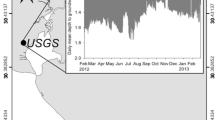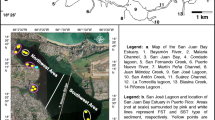Abstract
Microbial nitrate (NO −3 ) removal via denitrification (DNF) at high sulfide (H2S) concentrations was compared in sediment from a coastal freshwater pond in a developed area that receives salt-water influx during storm events, and a saline pond proximal to an undeveloped estuary. Sediments were incubated with added SO 2−4 (1,000 µg per gram dry weight basis (gdw)) to determine whether acid volatile sulfides (AVS) were formed. DNF in the sediments was measured with NO3–N (300 µg gdw−1) alone, and with NO3–N and H2S (1,000 µg S2− gdw−1). SO 2−4 addition to the freshwater sediments resulted in AVS formation (970 ± 307 µg S gdw−1) similar to the wetland with no added SO 2−4 (986 ± 156 µg S gdw−1). DNF rates measured with no added H2S were greater in the freshwater than the wetland site (10.6 ± 0.6 vs. 6.4 ± 0.1 µg N2O–N gdw−1 h−1, respectively). High H2S concentrations retained NH4–N in the undeveloped wetland and retained NO3–N in the developed freshwater site, suggesting that potential salt-water influx may reduce the ability of the freshwater sediments to remove NO3–N.


Similar content being viewed by others
References
Aelion, C.M., and J.N. Shaw. 2000. Denitrification in South Carolina (USA) coastal plain aquatic sediments. Journal of Environmental Quality 29: 1696–1703.
Aelion, C.M., and U. Warttinger. 2009. Low sulfide concentrations affect nitrate transformations in freshwater and saline coastal retention pond sediments. Soil Biology and Biochemistry 41: 734–741.
An, S., and W.S. Gardner. 2002. Dissimilatory nitrate reduction to ammonium (DNRA) as a nitrogen link, versus denitrification as a sink in a shallow estuary (Laguna Madre/Baffin Bay, Texas). Marine Ecology Progress Series 237: 41–50.
APHA. 1998. Standard methods for the examination of water and wastewater, 18th ed. Washington: American Public Health Association.
Brunet, R.C., and L.J. Garcia-Gil. 1996. Sulfide-induced dissimilatory nitrate reduction to ammonia in anaerobic freshwater sediments. FEMS Microbiology Ecology 21: 131–138.
Garcia-Gil, L.J., and H.L. Golterman. 1993. Kinetics of FeS-mediated denitrification in sediments from the Camargue (Rhone delta, southern France). FEMS Microbiology Ecology 13: 85–92.
Hosier, P.E. 1975. Dunes and marsh vegetation. In Environmental inventory of Kiawah Island, ed. W.M. Campbell and J.M. Dean. Columbia, SC: Environmental Research Center. Section D.
Hubert, C., and G. Voordouw. 2007. Oil field souring control by nitrate-reducing Sulfurosprillum spp. that outcompete sulfate-reducing bacteria for organic electron donors. Applied and Environmental Microbiology 73: 2644–2652.
Kim, D.H., O. Matsuda, and T. Yamamoto. 1997. Nitrification, denitrification and nitrate reduction rates in the sediment of Hiroshima Bay, Japan. Journal of Oceanography 53: 317–324.
Kostka, J.E., A. Roychoudhury, and P. Van Cappellen. 2002. Rates and controls of anaerobic microbial respiration across spatial and temporal gradients in saltmarsh sediments. Biogeochemistry 60: 49–76.
Kristensen, E., J. Bodenblender, M.H. Jensen, H. Rennenberg, and K.M. Jensen. 2000. Sulfur cycling of intertidal Wadden Sea sediments (Konigshafen, Island of Sylt, Germany):Sulfate reduction and sulfur gas emission. Journal of Sea Research 43: 93–104.
Laverman, A.M., P. Van Cappellen, D. van Rotterdam-Los, C. Pallud, and J. Abell. 2006. Potential rates and pathways of microbial nitrate reduction in coastal sediments. FEMS Microbiology Ecology 58: 179–192.
Li, W., Z. Q-L, and H. Liu. 2009. Sulfide removal by simultaneous autotrophic and heterotrophic desulfurization-denitrification process. Journal of Hazardous Materials 162: 848–853.
Ma, H., and C.M. Aelion. 2005. Ammonium production during microbial nitrate removal in soil microcosm from a developing marsh estuary. Soil Biology and Biochemistry 37: 1869–1878.
Rickard, D., and J.W. Morse. 2005. Acid volatile sulfide (AVS). Marine Chemistry 97: 141–197.
SAS (2003) Statistical Analysis System, SAS 9.1.3 (9.1 TS1M3) Service Pack 3 (SP3) by Statistical Analysis System Institute Inc., Cary, NC, USA
Senga, Y., K. Mochida, R. Fukumori, N. Okamoto, and Y. Seine. 2006. N2O accumulation in estuarine and coastal sediments: the influence of H2S on dissimilatory nitrate reduction. Estuarine, Coastal and Shelf Science 67: 231–238.
Simpson, S.L. 2001. A rapid screening method for acid-volatile sulfide in sediments. Environmental Toxicology and Chemistry 20: 2657–2661.
Sun, W., R. Sierra, and J.A. Field. 2008. Anoxic oxidation of arsenite linked to denitrification in sludges and sediments. Water Research 42: 4569–4577.
Truong, D.H., M.A. Eghbal, W. Hindmarsh, S.H. Roth, and P.J. O'Brien. 2006. Molecular mechanisms of hydrogen sulfide toxicity. Drug Metabolism Reviews 38: 733–744.
Tuerk, K., and C.M. Aelion. 2005. Microbial nitrogen removal in a developing suburban estuary along the South Carolina coast. Estuaries 28: 364–372.
Yin, S.X., D. Chen, L.M. Chen, and R. Edis. 2002. Dissimilatory nitrate reduction to ammonium and responsible microorganisms in two Chinese and Australian paddy soils. Soil Biology and Biochemistry 34: 1131–1137.
Zhou, Z., N. Takaya, A. Nakamura, M. Yamaguchi, K. Takeo, and H. Shoun. 2002. Ammonia fermentation, a novel anoxic metabolism of nitrate by fungi. Journal of Biological Chemistry 277: 1892–1896.
Acknowledgments
This research was funded by a grant from the National Oceanic and Atmospheric Administration, Office of Oceanic Research Programs (NA160A1427) and in part by the NOAA Center for Sponsored Coastal Ocean Research/Coastal Ocean Program, through the South Carolina Sea Grant Consortium pursuant to National Oceanic and Atmospheric Award No. NA960PO113. We thank Norm Shea and Kiawah Island for access to the field site, and two anonymous reviewers for their helpful comments.
Author information
Authors and Affiliations
Corresponding author
Electronic supplementary materials
Below is the link to the electronic supplementary material.
ESM 1
(DOC 48 kb)
Rights and permissions
About this article
Cite this article
Aelion, C.M., Warttinger, U. Sulfide Inhibition of Nitrate Removal in Coastal Sediments. Estuaries and Coasts 33, 798–803 (2010). https://doi.org/10.1007/s12237-010-9275-4
Received:
Revised:
Accepted:
Published:
Issue Date:
DOI: https://doi.org/10.1007/s12237-010-9275-4




